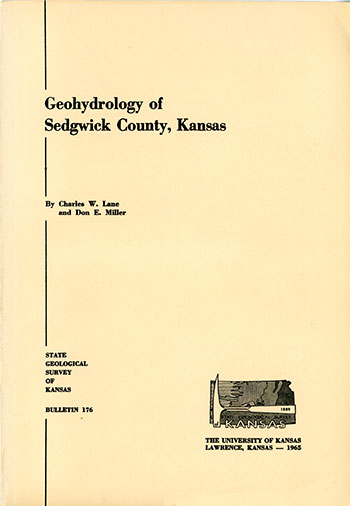Geohydrology of Sedgwick County, Kansas
by Charles W. Lane and Don E. Miller

Originally published in 1965 as Kansas Geological Survey Bulletin 176. This is, in general, the original text as published. The information has not been updated. An Acrobat PDF version (27 MB) is also available. Plates available separately.
You may also wish to visit our web site on the Sedgwick County geologic map.
Abstract
Sedgwick County has an area of about 1,000 square miles and lies within the Arkansas River Lowlands of the Central Lowland physiographic province. It is drained by the Arkansas River, Little Arkansas River, Ninnescah River, and tributaries of the Walnut River. The normal annual precipitation at Wichita, the principal city, is 30.70 inches, but it is subject to wide extremes.
The County contains about 15.7 percent of the State's population, and Wichita is the largest city in the State, with a population of about 254,700. It is the most heavily industrialized area of the State. The principal industry is the fabrication of private and military aircraft. The processing of agricultural products and petroleum, metal fabrication, and chemical manufacture are also important industries.
The rocks that crop out in the County are of sedimentary origin and range in age from Permian to Recent. The Wellington Formation of Permian age is the oldest rock cropping out. The surficial materials over much of the County are unconsolidated deposits of clay, silt, sand, and gravel of Neogene age. The unconsolidated deposits are thickest and are areally most extensive underlying the broad alluvial plain flanking the Arkansas River. The geologic history of the Arkansas Valley is discussed in detail in a section of this report.
Ground water is the most important mineral resource of Sedgwick County. It constitutes essentially all water used in the County. The quantity of ground water withdrawn cannot be determined accurately, but water rights in the amount of about 190,800 acre-feet have been approved or are pending approval in the County for all uses. The principal source of the ground water is the unconsolidated deposits underlying the Arkansas Valley where well yields of from a few gallons per minute to over 2,000 gallons per minute are readily obtained. The chemical quality of the ground water ranges from moderately hard to extremely hard, depending on the source of the water, Ground water in the Arkansas Valley is generally of moderate hardness, but locally it contains undesirable quantities of dissolved salt and iron. Water from the Permian rocks is generally extremely hard and of limited usefulness owing to its high content of chloride and sulfate ions.
The ground-water reservoir is recharged by precipitation in Sedgwick County and adjacent areas. Subsurface inflow and outflow are about balanced. Ground water discharge is principally by seepage into streams and by evaporation and transpiration, and withdrawal by wells has reached significant proportions.
Maps of Sedgwick County included in this report show the outcrop areas of the rocks, the lines of geologic cross sections, the configuration of the Permian bedrock surface, the shape and slope of the water table and location of wells, springs, and test holes for which records are given, generalized ground-water areas, thickness of sand and gravel deposits in the Arkansas Valley, the estimated transmissibility of the unconsolidated rocks in the Arkansas Valley, the distribution of chlorides in the ground water, the distribution of dissolved solids in the ground water, and areas where additional large ground-water supplies might be developed.
Kansas Geological Survey, Geology
Placed on web Nov. 1998; originally published Dec. 1965.
Comments to webadmin@kgs.ku.edu
The URL for this page is http://www.kgs.ku.edu/General/Geology/Sedgwick/index.html